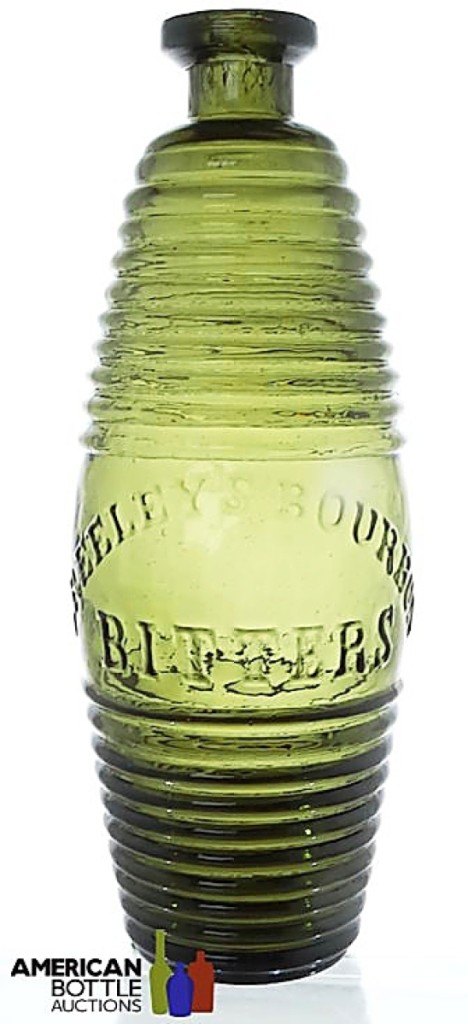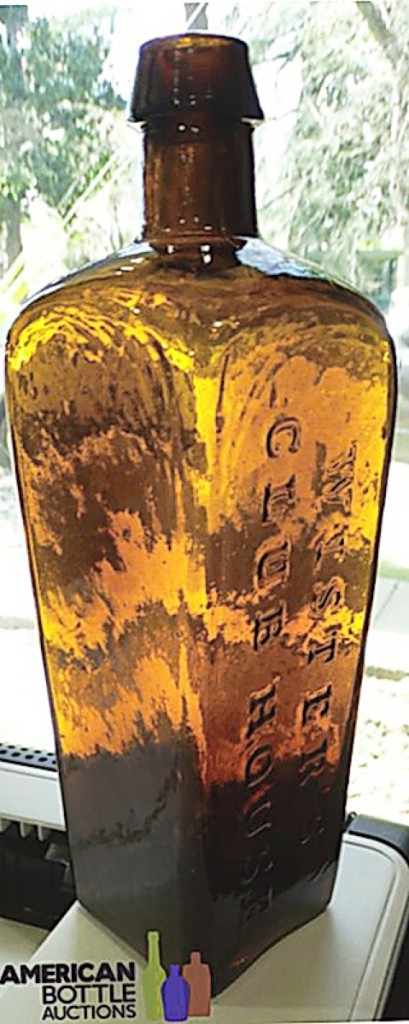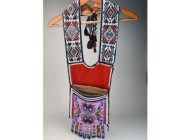
Leading the sale at $29,900, a new auction record, was a Miller’s Ratafia Bitters. American Bottle Auctions owner Jeff Wichmann said, “No example has sold for more than $10,000 that we are aware of,” and to his knowledge the only western made bitters made with a picture of a Sphinx prominently displayed front and center on the bottle. It was won by a West Coast collector.
Review by W.A. Demers, Photos Courtesy American Bottle Auctions
SACRAMENTO, CALIF. – Part II of the Mel Hammer bottle collection – gathered over a 50-year span by a man who dedicated much of his adult life to the acquisition and study of antique glass – was sold in an online auction that closed on March 14 by American Bottle Auctions. The offerings featured Hammer’s favorites, including schnapps and gin bottles, bitters bottles and inkwells, many boasting 9.5 grades and a myriad of colors. The auction itself was “white glove,” meaning 100 percent sold. Hammer died on Thanksgiving Day in 2021, and this second session completed the dispersal of his collection.
The sale totaled $195,000, a strong result, according to American Bottle Auctions owner Jeff Wichmann with 185 registered bidders chasing 154 lots. “We weren’t sure about how well it was going to do, and on the last day we went from about $90,000 to $195,000, so that’s like $100,000 on the last day.” Leading the sale at $29,900, a new auction record, was a Miller’s Ratafia bitters. Wichmann said, “No example has sold for more than $10,000 that we are aware of.” These interesting bottles are known by collectors as the odd-sized whiskey-shaped amber bottle, but mostly they are the antique bottle with a Sphinx on it. “Collectors of western bitters and bottles in general are always on the lookout for picture whiskeys, and although we’ve seen racehorses, eagles, a Phoenix and deer and elk heads, along with a lot more, to our knowledge this is the only western-made bitters made with a picture of a Sphinx prominently displayed front and center on the bottle.”
The Miller’s Ratafia were made from around 1878 to 1882. The earliest known address for the Siebe Brothers was on the southwest corner of Pacific and Stockton Streets in San Francisco in 1859. Later the store became the property of John Siebe and moved to Union and Powell Streets. Eventually John got back together with his brother Frederick and they opened a grocery liquor store around 1866. By 1877 they created their own wholesale liquor company and decided they needed to furnish their own bitters product. They met a Dr Charles P. Miller, who happened to be a noted physician in San Francisco at the time and hired him to concoct a bitters in which they could bottle and distribute with their name.

A green Greeley’s Bourbon bitters performed well, finishing at $8,050. These are considered rare in this green coloration, especially in this condition, graded 9.
The Miller bottles come in a sixth size and are always shades of amber. These hard-to-find western bitters have been mostly dug in California, Vallejo, Mariposa and Nevada City and in neighboring states, including Nevada. “We don’t often hear much about a Miller’s Ratafia changing hands, we believe that’s because there just aren’t enough to go around,” said Wichmann. “Collectors who own one rarely want to part with them, and new finds are quickly bought up. Since they are so hard to find collectors pay a premium.” A West Coast collector purchased it.
Gins brought some knockout prices. “We had a lot of people jumping in on items that we really did not think were going to go that high,” said Wichmann. A Charles Cordial Gin, London, 9¼ inches tall with iron pontil sold for $3,680. Repeating the super crude nature of these bottles with sticky ball pontil and crudely applied top, the bottle featured an unusual shape, which, according to the catalog, “might be more at home disguised as a Clubhouse Gin or Catawba Wine Bitters. “
Regardless, this one is a top example with everything going for it. It’s almost the bigger twin to the previous lot.
Crowing at $5,320, a T.J. Dunbar & Co Gin pictured a rooster and below that the words Tail Boston. The Dunbar Company utilized a rooster to convey the fact that this bottle held a gin cocktail. Interestingly, the catalog pointed out, the word “Gin” is in a slugplate, which might mean that they changed it for other types of alcohol.
From barnyard to paddock, equestrian sensibilities were on display with a London Jockey Club House Gin with an embossed horse and rider and two backward “Ns” on the iron pontil, which realized $4,830. Sole Agents for this brand were James Patrick & Co. San Francisco. Wichmann said that it’s a bottle that is quite familiar to western bottle collectors and comes in different colors. “We believe this example is one of the earliest produced. Desired by collectors for a number of reasons, which include the embossed horse and rider and two backward N’s along with an iron pontil. Since this example has the backward letters and iron pontil along with a bright green hue, we believe that this was one of the first examples made for the company. It’s apparent that Mel wanted to find one of the early examples, and it appears he was successful.”
Also bearing an iron pontil was a Wister’s Club House gin bottle that took $10,350. According to noted local author and historian Warren Friedrich, “The Wister’s Clubhouse Gin bottles are much earlier than 1863. They are an eastern manufactured product of which a couple hundred cases were acquired by a commission house in San Francisco and sold at auction during each week in June and July of 1863. No advertisements for this product have ever been found; while the product was being marketed in any western newspapers, I suspect it was very short lived with all the other competition at the time.” This was is an apricot example with all the graphite intact and loads of crudity. These come in more than a couple different colors. A side note, this was the last bottle Hammer bought from American Glass Auctions.
Fetching $3,680 and graded a 9+ was a J.T. Daly Club House with backward “s” and iron pontil. The sole agents for this gin were Wm. Newell & Co. of San Francisco. A bottle that never seems to lose favor with collectors in the West, the early ones have the backward “S” and the iron pontil. This has the typical applied square collar with a “drippy” top. Daly produced a number of different shaped bottles, some very early on. The other name that appears on another variant is “William.”

The last bottle the late Mel Hammer bought from American Glass Auctions was this Wister’s Club House gin bottle, which took $10,350. According to noted local author and historian Warren Friedrich, “The Wister’s Clubhouse Gin bottles are much earlier than 1863. They are an eastern manufactured product of which a couple hundred cases were acquired by a commission house in San Francisco and sold at auction during each week in June and July of 1863.
More notable bitters performed well in this sale. A green Greeley’s Bourbon Bitters was bid to $8,050. These are considered rare in this green coloration, especially in this condition, graded 9.
And a Bryant’s Stomach Bitters with applied top with early pontil, circa 1857-63, had “legs” and settled at $6,900. These come in two variants, one with more than a dozen examples being found on a shipwreck off the coast of Brazil. This example is not one of the shipwreck variants, but was a nice example in a medium hue with lots of crudity.
Prices given include the buyer’s premium as stated by the auction house. The next sale will takle place in about three months’ time, date to be announced.
For information, 916-443-3210 or www.americanbottle.com.













